Vietnamization
President Nixon’s plan for getting out of Vietnam? Turn the battle against Communism over to the South Vietnamese
“We Americans are a do-it-yourself people.… Instead of teaching someone else to do a job, we like to do it ourselves. And this trait has been carried over into our foreign policy,” President Richard Nixon told the nation in a televised address on November 3, 1969, explaining that the United States would no longer take the lead in the fight against the North Vietnamese. Instead, US forces would train the South Vietnamese military to handle the conflict on its own.
“In the previous administration,” Nixon said into the camera, “we Americanized the war in Vietnam. In this administration, we are Vietnamizing the search for peace.”
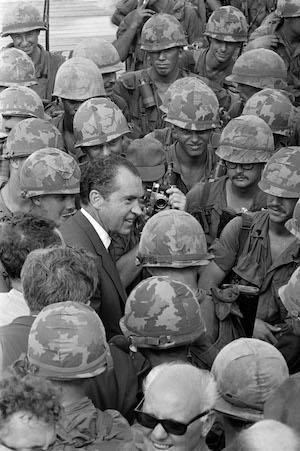
This strategy—dubbed “Vietnamization” by Secretary of Defense Melvin Laird and the “Nixon Doctrine” by the press—was best captured, Nixon said, by a leader of another Asian country who once told him: “When you are trying to assist another nation defend its freedom, US policy should be to help them fight the war but not to fight the war for them.”
In addition to a withdrawal of US forces, Nixon pledged an increase in the training and equipping of the South Vietnamese military, as well as an adherence to all treaty commitments. “This withdrawal will be made from strength and not from weakness,” he asserted. “As South Vietnamese forces become stronger, the rate of American withdrawal can become greater.”
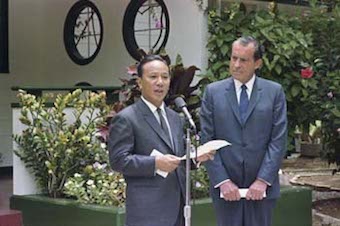
Referencing the massive antiwar protests on the home front, Nixon asked those who were not protesting—the “great silent majority of my fellow Americans”—for their support of his withdrawal plan. It was a winning one-liner with longevity, as this televised address (below) is widely referred to as Nixon’s “silent majority” speech.
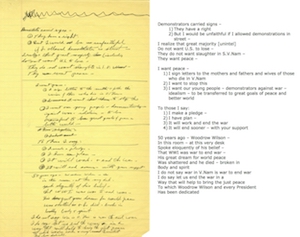
INCURSION INTO CAMBODIA
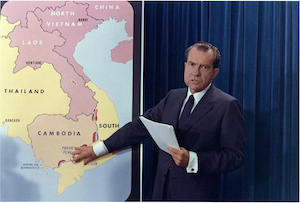
In his first year, Nixon attempted to settle the war on favorable terms. But when negotiators failed to make progress through the public peace talks being held in Paris, Nixon turned to more clandestine channels. Through secret negotiations between National Security Advisor Henry Kissinger and the North Vietnamese, the president warned that if major progress was not made by November 1, 1969, he would be “compelled—with great reluctance—to take measures of the greatest consequences.”
None of it worked. The North Vietnamese did not yield. Nixon did not carry out his threats; the war continued. Bringing the conflict to a successful resolution proved elusive.
Publicly, Nixon said his strategy was a combination of negotiating and Vietnamization. In fact, he began the withdrawals even before he issued his secret ultimatum to the Communists, and he continued to announce partial troop withdrawals throughout his first term.
But Vietnamization could work only if American withdrawal was offset by improvement in Saigon’s fighting capacity. And with Communist forces continuing to move down the Ho Chi Minh trail through Laos and Cambodia and on into South Vietnam, the Army of the Republic of Vietnam (ARVN) would remain continually under siege.
By the spring of 1970, developments in the region seemed to offer a way not only to take the heat off the South Vietnamese, but to deal the Communists a more punishing blow.
A Cambodian coup in March 1970 had replaced neutralist leader Prince Sihanouk with a pro-American military government, albeit of dubious survivability. American officials also believed they had located in Cambodia the Central Office of South Vietnam (COSVN)—the headquarters for Communist operations below the 17th parallel. Seeking to bolster the fledgling force in Cambodia and to strike at COSVN, as well as to buy time for ARVN’s improvement, Nixon ordered a temporary invasion of Cambodia—the administration called it an incursion—by a combined force of American and South Vietnamese troops.
On April 28, 1970, the president authorized a preemptive strike in Cambodia, sending US troops across the border from South Vietnam in order to destroy Viet Cong base camps that were providing support to the Communists fighting in South Vietnam.
Two days later, Nixon took to the airwaves again, to explain to the American people that the US military, along with the South Vietnamese People’s Army, were invading Cambodia in order to intensify the destruction of Viet Cong base camps and to impede North Vietnamese supply lines.
Several years later, looking back on the bombing and incursion in Cambodia, Nixon revealed in the recording below how those actions destabilized the Southeast Asian nation. Nixon told Treasury Secretary John B. Connally that it was a mistake for him not to retaliate militarily against North Korea after it shot down an American EC-121 reconnaissance plane in April 1969, shortly after he became president. He recalled the great popularity of his “silent majority” speech, then revealed to Connally for the first time that in 1969 he had secretly ordered American B-52s to bomb the Ho Chi Minh Trail in the border area of Cambodia. The code name was Operation Menu, with individual rounds of bombing named Breakfast, Lunch, Dinner, Supper, and Snack.
The assault had an unintended consequence: It drove the North Vietnamese deeper into Cambodia, destabilizing the neutralist government. Read the transcript here.
KENT STATE

The Cambodian incursion energized lawmakers on Capitol Hill to claw back some of the power it had ceded to the executive during the course of the war. Not only did it generate proposals to limit the powers of the president; it sparked bipartisan legislation to limit US military action in Cambodia and to end the American war in Vietnam.
The Cambodian operation also provoked the largest round of antiwar rallies in American history. In response to the protests specifically at universities, according to the New York Times, Nixon told Pentagon civilian employees on May 1, 1970: “You see these bums, you know, blowing up the campuses. Listen, the boys that are on the college campuses today are the luckiest people in the world, going to the greatest universities, and here they are burning up the books, storming around about this issue. You name it. Get rid of the war there will be another one.
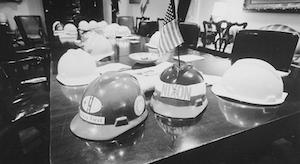
“Then out there we have kids who are just doing their duty. They stand tall and they are proud. I am sure they are scared. I was when I was there. But when it really comes down to it, they stand up and, boy, you have to talk up to those men. They are going to do fine and we have to stand in back of them.”
It was during these campus demonstrations in May 1970 that National Guardsmen fired at rock-throwing protestors at Kent State University in Ohio, killing four. Two weeks later, police fired on students at Jackson State University in Mississippi, leaving two more dead.
THE WITHDRAWAL
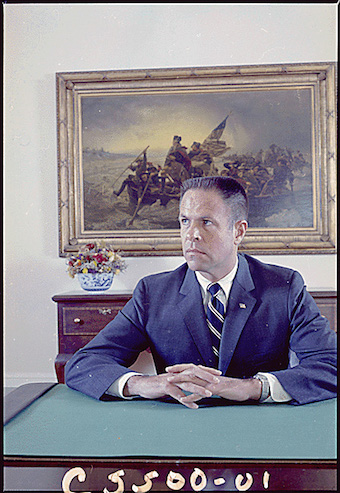
By the end of 1970, Nixon had planned to wrap up the American military withdrawal from Vietnam within 18 months. But Kissinger talked him out of it. Nixon's chief of staff, H.R. Haldeman, documented a discussion about the president's plans in his diary on December 21, 1970:
"Henry was in for a while and the president discussed a possible trip for next year. He's thinking about going to Vietnam in April [1971] or whenever we decide to make the basic end-of-the-war announcement. His idea would be to tour around the country, build up [South Vietnamese President Nguyen Van] Thieu and so forth, and then make the announcement right afterwards. Henry argues against a commitment that early to withdraw all combat troops because he feels that if we pull them out by the end of '71, trouble can start mounting in '72 that we won't be able to deal with, and which we'll have to answer for at the elections. He prefers instead a commitment to have them all out by the end of '72 so that we won't have to deliver finally until after the [US presidential] elections [in November 1972] and therefore can keep our flanks protected. This would certainly seem to make more sense, and the president seemed to agree in general, but he wants Henry to work up plans on it."
MISSION IN LAOS
Communist supply lines running along the Ho Chi Minh trail from North Vietnam, through Laos, and south to Cambodia were a logical target for interdicting the North’s operation. But American troops were not able to take part in ground combat operations in either Laos or Cambodia because of the Cooper-Church Amendment, passed by Congress in late 1970, prohibiting such action on the ground.
US troops could, however, assist from the air. So on February 8, 1971, South Vietnamese ground forces, with American air support, took part in Lamson 719, an offensive in Laos intended to sever the Ho Chi Minh trail. Lamson was considered at least a partial test of the success of Vietnamization. It went badly, but did manage to disrupt Communist supply lines long enough to aid the war effort.
In this recording from March 11, 1971, Nixon and Kissinger discussed the timing of the South Vietnamese military’s departure from Laos as it concluded Lamson 719. Read the transcript here.
MORE PROTESTS ON THE HOMEFRONT
On the eve of mass antiwar demonstrations in April and May of 1971, the president’s pollsters found just 28 percent in favor of the protests and 65 percent opposed. President Nixon smelled opportunity, telling Haldeman to “make a note there: Take on the f**king demonstrators.”
But in April 1971 when the Vietnam Veterans Against the War (VVAW) arrived in the nation’s capital with plans for a weeklong protest, Nixon responded more gingerly. The Interior Department had denied the VVAW permission to encamp overnight on the National Mall, but the group set up anyway, filing appeals that they ultimately took to the Supreme Court. Recalling the public outcry when President Herbert Hoover ordered the Army to evict the Bonus Expeditionary Force—a large group of WWI veterans demanding cash payments during the depths of the Great Depression—Nixon instructed White House special counsel John W. Dean that no one, including DC police, should touch the Vietnam veterans.
Two days later, in this Oval Office conversation, Nixon and his advisors discussed the recent press coverage of VVAW. They were particularly impressed by the performance of John F. Kerry before the Senate Foreign Relations Committee the previous day.
Kerry's testimony included sharp accusations of war crimes being committed on a daily basis by US troops, with the full awareness of officers at all levels of command.
The protests continued. On May 3, 1971, police clashed with the self-described “Mayday Tribe”—antiwar protesters who demonstrated for three days in DC. They tried blocking traffic and courting mass arrest in an attempt to bring the city to a halt—and with it, the war.
They succeeded in getting arrested, making people late for work, and providing the president with the political opportunity to take a popular hard line against disruptive protest. They did not, however, succeed in shortening the war.
The president hoped to bring the last American troops home from Vietnam sometime between July 1972 and January 1973, when enough US troops remained in South Vietnam to prevent the fall of Saigon before Election Day 1972. In the meantime, he relished the opportunity to score political points off the unpopular demonstrations, as this conversation indicates. Read the transcript here.
PENTAGON PAPERS
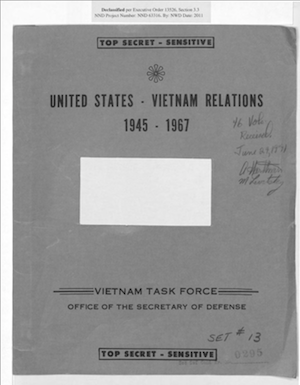
A defense analyst specializing in nuclear weapons strategy and counterinsurgency theory, Dr. Daniel Ellsberg was a member of the Vietnam Study Task Force created in 1967 to study the history of America’s role in Vietnam. His brief stint with the task force confirmed what he had already come to suspect: The US government’s involvement in Vietnam was one of deception. Ellsberg became increasingly frustrated with the Nixon administration, believing that its conduct in Vietnam was merely a continuation of his predecessors’ patterns of deception and escalation. As his frustration grew, Ellsberg began to contemplate leaking the study so that its contents and its lessons could be made public.
Over the course of several weeks in the fall of 1969, Ellsberg managed to secretly photocopy the study. With these copies in his possession, Ellsberg turned to members of Congress such as Senator J. William Fulbright (D-AK), Senator Charles Mathias Jr. (R-MD), Senator George McGovern (D-SD), and Congressman Paul (Pete) McCloskey Jr. (R-CA), all in the hope that one of them would be willing to enter the Pentagon Papers into the Congressional Record. Despite his pleas, all four declined. But Senator McGovern suggested that he provide his copies to the press. So in March 1971, Ellsberg decided to show the study to New York Times reporter Neil Sheehan.
Sheehan and the Times understood how big of a story they had. On June 10, word reached Sheehan that against the advice of the paper’s attorneys, the management of the Times had decided that the need to reveal the history of deception outweighed the danger of possible criminal prosecution. The New York Times published its first Pentagon Papers article on Sunday, June 13, 1971. It was, the Times announced, part one of a series.
Taking legal action against the Times was not Nixon’s first reaction. In a June 13, 1971, conversation with Kissinger, the president recognized that in some ways the publication of the Pentagon Papers helped him politically, since the study reminded readers that the Vietnam War was more the product of his predecessors’ mistakes than his own. Nixon and Kissinger both assumed, mistakenly, that the release of the study was timed to affect an upcoming vote on the McGovern-Hatfield Amendment, which would require the withdrawal of US forces from Vietnam. To be sure, Nixon denounced the publication as “unconscionable” and worse, but the lesson he drew from it was that the administration should just plow ahead and make sure to “clean house” of disloyal people who might partake in such a “treasonable” act.
BROOKINGS BREAK-IN
In response to the leak of the Pentagon Papers, the president met in the Oval Office on June 17, 1971, with his closest aides. Haldeman suggested blackmailing Nixon’s predecessor, President Lyndon B. Johnson, on the Vietnam issue that nearly cost Nixon the 1968 presidential election: the “bombing halt." Less than a week before the election, Johnson had ordered a complete halt to American bombing of North Vietnam in exchange for secret military concessions by Hanoi and the start of new peace talks between North and South Vietnam. Republicans charged that Johnson had stopped the bombing to bolster the presidential campaign of Hubert H. Humphrey, Johnson’s vice president. (The declassified record shows otherwise.)
Nixon’s reaction to Haldeman’s suggestion stunned his aides. He told them to implement the Huston Plan, which called for using illegal break-ins, wiretaps, and mail-opening against domestic terrorists. But instead of terrorists, Nixon wanted to use the plan against former Johnson administration officials who (the president mistakenly believed) had a secret file on the bombing halt in a classified safe at Brookings. Read the transcript here.
NIXON’S REELECTION
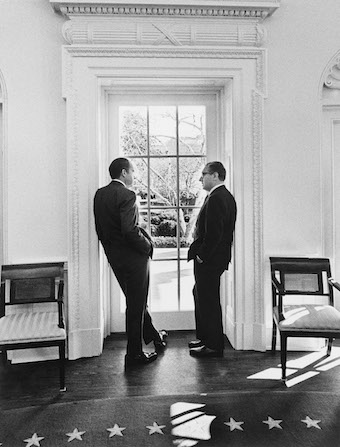
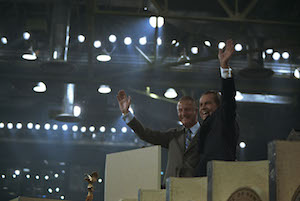
Nixon and Kissinger’s worst fears were realized when the North Vietnamese regular army poured into the South in March 1972. Nixon responded by implementing some of the plans he had considered in 1969. He mined Haiphong Harbor and used B-52s to bomb the North. The combined power of the American and South Vietnamese military ultimately stopped the offensive, though not before the Communists had more territory under their control.
The North Vietnamese were eager to reach a settlement before the American presidential election, after which Nixon would no longer have to face the electorate at the ballot box. Hanoi made a breakthrough proposal in October 1972 and reached agreement with Kissinger rapidly. The South Vietnamese government balked, however, chiefly because the agreement preserved North Vietnamese control of all the territory Hanoi currently held. To turn up the political pressure on Nixon, the North Vietnamese began broadcasting provisions of the agreement. Kissinger held a press conference announcing that “Peace is at hand,” without giving away too many details.
After Nixon's re-election, he told South Vietnamese president Thieu that if he did not agree to the settlement, Congress would cut off aid to his government—and that conservatives who had supported South Vietnam would lead the way. He promised that the United States would retaliate militarily if the North violated the agreement.
To coax Saigon into signing the agreement, and to bring Hanoi back to the conference table, Nixon launched the "Christmas Bombings" of 1972. Both parties responded as Nixon desired, and peace seemed imminent. Negotiations resumed in January to resolve the few outstanding issues that remained.
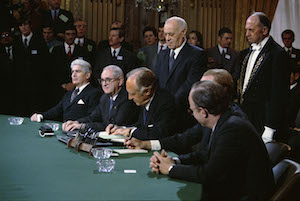
In this recorded conversation from January 23, 1973, Nixon laments the news coverage of him finally ending this unpopular war. "You'd think, you know, that even at this time, even those a**holes would say, 'Well, you know...maybe it's good news.' But no!" Nixon told Kissinger. Four days later, the Paris Peace Accords went into effect, bringing an end to the American war in Vietnam.
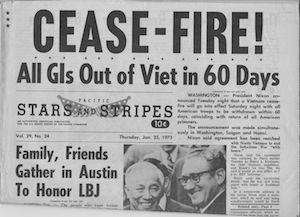
In his last statement as defense secretary in 1973, Laird said, “Vietnamization…today is virtually completed.... The South Vietnamese people today, in my view, are fully capable of providing for their own in-country security against the North Vietnamese.”
That statement would prove incorrect within two years. On April 30, 1975, the People's Army of Vietnam and the National Liberation Front of South Vietnam captured Saigon, thus eliminating the dividing line at the 17th parallel and reunifying North and South under a Communist regime. America's ally South Vietnam had lost the war.
*Adapted from “Richard Nixon: Foreign Affairs” by Ken Hughes and “First Domino: Nixon and the Pentagon Papers”—both first published on millercenter.org.